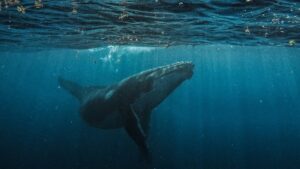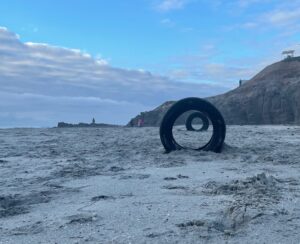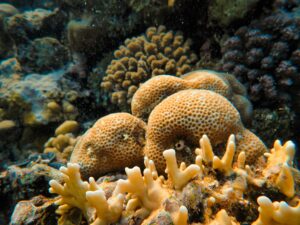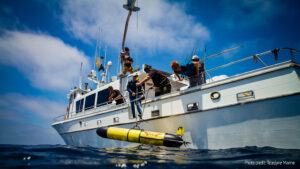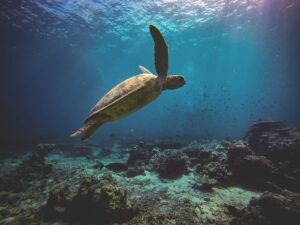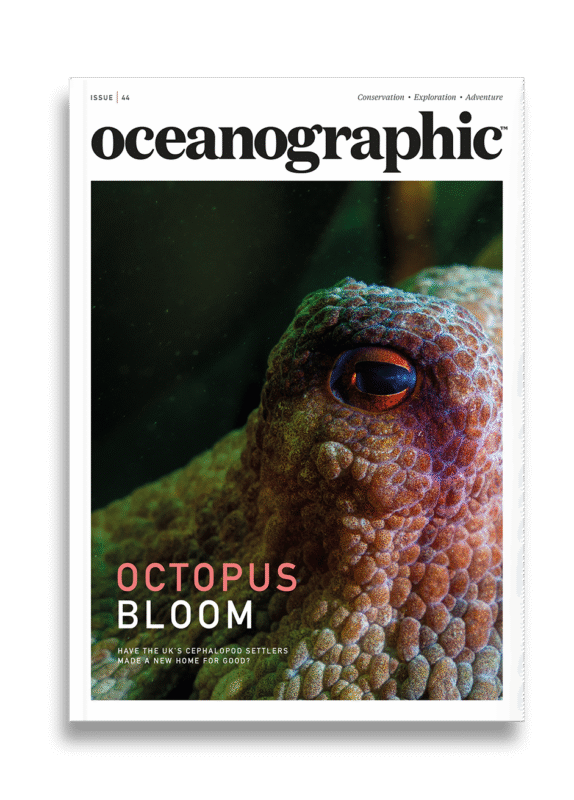'Dinosaur fish' thought extinct reveals itself in Blancpain mission
On an expedition backed by the dive watch specialists, Blancpain explorers from UNSEEN Expeditions capture the first footage of a species of coelacanth thought to have vanished some 700 million years ago - a groundbreaking discovery for science and conservation.
A ‘dinosaur fish’ once believed to have vanished from the Earth some 70 million years ago has come back from the dead to reveal itself to underwater explorers pioneering new discoveries in the Maluku Archipelago in Indonesia.
This ‘living fossil’ marks the first time that the coelacanth of the Maluku archipelago, a species native to this specific region of Indonesia, has been captured on camera, in its habitat, alive, and more than a decade on from the moment underwater photographer, Laurent Ballesta made history with his own encounter with the West Indian Ocean species, in South Africa.
This documented ‘return of the coelocanth’ was part of a wider expedition backed by the dive watch specialist, Blancpain.
The honour of making the discovery fell to the underwater photographer and explorer, Alexis Chappuis from UNSEEN Expedition, now credited with bringing back the first images of this species – the Indonesian coelacanth (Latimeria menadoensis) – ever taken by divers in its natural habitat, some 145 meters beneath the water’s surface.
The coelacanth – often mistakenly called a ‘living fossil’ or a ‘dinosaur fish’ had been known from fossils dated back more than 400 million years – way before dinosaurs – and was thought to be extinct until 1938, when a specimen was discovered in a fishing newt off the coast of South Africa. Its discovery back then was marked as one of the biggest Natural History findings of the 20th Century.
Given that it was thought to be extinct for the last few million years, it’s little surprise to find both extant coelacanth species on the IUCN Red List, with the West Indian Ocean Latimeria chalumnae listed as ‘critically endangered’ and the Indonesian Latimeria menadoensis listed as ‘vulnerable.’ Their elusive nature and iconic status make coelacanths a flagship species in bringing attention – both local and international – to conservation efforts.
In 2013, the world-renowned diver and longstanding partner of the Blancpain brand, Laurent Ballesta together with his team, became the first divers to study and document living coelacanths in their natural habitat. Today, Alexis Chappuis, leader of UNSEEN Expeditions has achieved a similar milestone – being the first to photograph the Indonesian species.
Overcoming the extreme technical challenges of deep mixed-gas diving, both teams captured unique in situ images of the two known living species of coelacanths at 120 and 145 metres.

The discovery was made during a morning deep dive in October 2024 in which the team used closed-circuit rebreathers and trimix breathing gases, reaching a depth of 125 metres. The encounters lasted about five minutes for the first dive and eight minutes for the second, before the divers had to start making their way up to the surface.
For just a few minutes at these depths, divers need hours of decompression, floating a few metres beneath the surface, in the open ocean.
Since 2020, Blancpain has been supporting a long-term collaboration led by Alexis Chappuis and UNSEEN Expeditions, along with international and local scientific partners, to document the largely unexplored mesophotic zone and eventually discover potential coelacanth habitats. In this context, the discovery of the very first coelacanth of the Maluku archipelago adds crucial knowledge to the distribution of the Indonesian species, Latemeria menadoensis, aiding in the understanding and conservation of this ancient lineage.
The research paper – First record of a living coelacanth from North Maluku, Indonesia – has been published in the scientific paper, Nature.
While in his paper, Chappuis suggests it is “too early to discuss a new Malukan coelacanth population” he admits that “since the Maluku archipelago is located between Sulawesi and Western New Guinea, “it is unlikely that only one individual lives in the broad region.”
“Our recent sightings, combined with the work we have conducted on mesophotic coral ecosystems of the Maluku archipelago since 2022, not only confirm the presence of Latimeria but also – more widely – the existence of suitable coelacanth habitats,” writes Chappuis.
“This is good news for the conservation of this highly vulnerable vertebrate and supports the hypothesis that Indonesian coelacanths might present a more extensive distribution range than initially thought. It also highlights the importance of Eastern Indonesian waters as a marine biodiversity hotspot and reminds us of the necessity of protecting deep-reef ecosystems from human activity as they host endemic, sensitive, and threatened species.”
Chappuis believes this Blancpain-backed expedition could also open the door to a future of non-invasive research on Indonesian coelacanths.
“For example, in the future, it should be possible to collect in situ DNA samples from living specimens without having to harm or catch them, which would provide critical information about the nature, composition, and repartition of Latimeria across Indonesia,” he said.
“Meanwhile, we hope this discovery will encourage local and national authorities to increase conservation efforts in this vibrant and biodiverse region, which is now confirmed to be hosting one of the most elusive and emblematic marine species found in Indonesian waters.”


"*" indicates required fields
Printed editions
Current issue
Back issues

Back Issues
Issue 43 Sir David Attenborough’s ‘Ocean’

Back Issues
Issue 41 Holdfast to the canopy
Enjoy so much more from Oceanographic Magazine by becoming a subscriber.
A range of subscription options are available.

